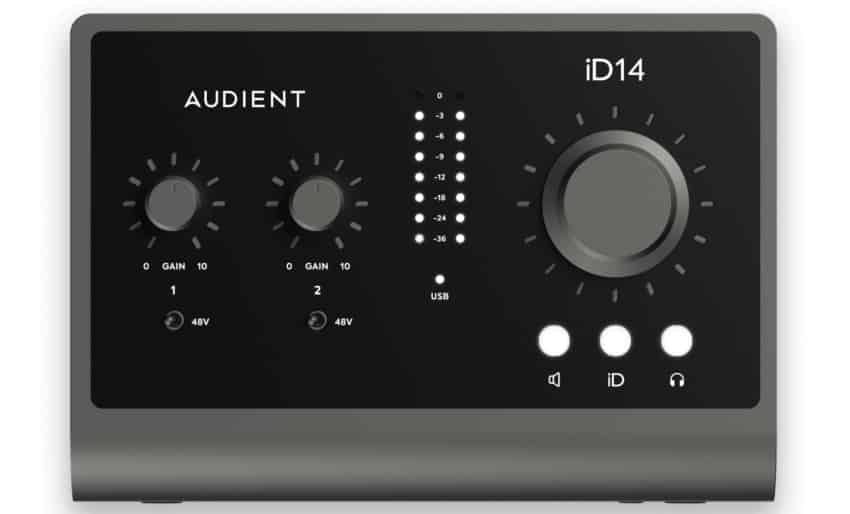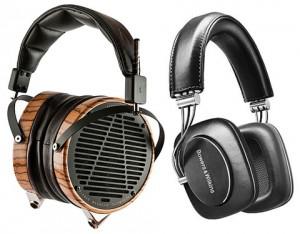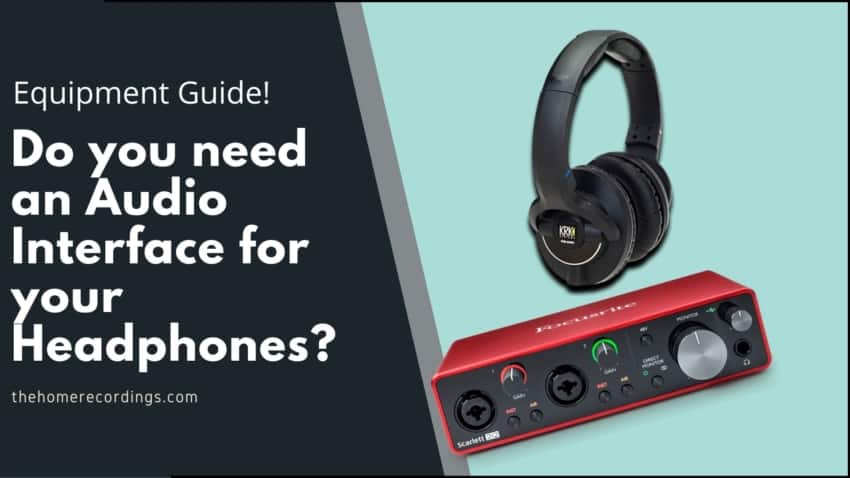Last updated on December 31st, 2023 at 06:04 pm
Audio Interfaces are an essential component of every small and even large music studio, but “those are mainly used for recording audio”, you say?
Well, yes, but they also have a lot of added benefits and may improve the audio quality of your headphones as well as speakers (very slightly and barely noticeable, however).
In this article, I will go over if you need an audio interface for just listening to music on headphones, if you need one for music production, as well as some things you should consider when making your choice.
So, without any further ado, let’s get started!
Do you need an Audio Interface for your Headphones?
Audio Interfaces convert the digital signal coming from the computer into an analog audio signal that gets reproduced by the headphone’s drivers. The better the digital-to-analog conversion, the better the overall audio quality. For general music listening, an audio interface is not necessary, but it is recommended for music production.
There’s definitely a lot more to it, especially for anyone who is interested in producing music, mixing, recording, etc. But if you’re only interested in listening to music through your headphones, then don’t waste time and money and don’t purchase an Audio Interface since the one that comes built-in in your PC (the sound card) is more than enough to reproduce high-quality audio.
Just make sure that the headphones you own/buy don’t have too high of an impedance level, otherwise the built-in sound card won’t be able to properly drive them.
To further understand why an audio interface can reproduce audio with a better overall quality, let’s take a quick look at how it works:
What does an Audio Interface do?

An Audio Interface is designed to take the analog signal coming from any recording equipment, convert it into a digital signal that can be recorded by the computer, and to play back any digital data on the computer by converting that into an analog signal again.
This is called analog-to-digital and digital-to-analog conversion.
As far as what an Audio Interface does, this is essentially it and even your PC’s built-in sound card does this as well since it’s technically an audio interface.
Of course, dedicated audio interfaces have more features and produce better audio quality in general, both when recording and reproducing audio.
Difference between your PC’s built-in sound card and a dedicated Audio Interface
While a dedicated audio interface and a built-in sound card do essentially the same (A/D and D/A conversion), a computer’s sound card doesn’t feature as many inputs and outputs, MIDI I/O, Phantom Power, Optical Inputs for expanding the overall input count, S/PDIF, higher quality preamps, dedicated audio drivers that can manage much lower latency levels, better A/D and D/A conversion, etc.
A couple decades ago, built-in sound cards were nowhere near as good at reproducing audio with the same quality as today, but modern built-in sound cards are now so capable that you won’t be able to tell the difference anymore.
However, a dedicated Audio Interface also:
- Has better converters
- Can Drive Higher Impedance Headphones
- Introduces less noise
Let’s take a quick look at each of these statements:
A dedicated Audio Interface has Better Converters
An Audio Interface’s sole purpose is to record and reproduce audio with the higher fidelity & quality possible, which is why they are used for producing music since this is where you need the highest quality of audio.
This is not only achieved through an Audio Interface’s preamps, which can boost the recording equipment’s signal to line level without introducing any noise whatsoever, but also through its converters (A/D and D/A conversion) which are more capable than the ones found on regular PC sound cards.
It can drive high impedance headphones
Some headphones, like the Sennheiser HD650, are really hard to drive and require an external amplifier that can provide them with enough power. PC sound cards, just like your smartphone, are not capable of properly driving those kinds of headphones, whereas most audio interfaces are (maybe not the super cheap ones).
However, most closed back headphones (more on the difference between open and closed back headphones in a second) generally are low impedance and can be driven by almost any device.
What happens if you try to drive High impedance headphones without having the necessary power?
Generally, what you’ll notice is a lack of volume, and even at full blast you may only be able to hear the audio very quietly. Additionally, the overall audio quality may be slightly degraded and more noise may be introduced.
It introduces less noise
While this is becoming less and less common, your computer’s sound card may generate a bit more noise, such as static/white noise, than a dedicated audio interface because it’s part of the same system, and anything that happens inside of your PC may introduce a little bit more noise.
Now, even though I already mentioned this a couple times throughout the article, here’s a very important question you need to ask yourself:
Are you Mixing or just listening to Music?
If you are looking to produce music, mix or even master audio, then your needs will be vastly different than if you only want to listen to music in your free time, and the equipment required for those purposes will be very different as well.
Like I previously mentioned, music production usually requires quality equipment that can both record and reproduce audio without altering it in any way so that the end product sounds as good as possible.
In addition to this, producing music involves more equipment which has to be connected to the computer somehow, and this is usually done through the audio interface; like microphones and other instruments.
If you only want to listen to music through your headphones and are not thinking about ever recording audio, then don’t bother getting an Audio Interface, it doesn’t make any sense since you won’t be able to tell the difference in audio quality because of how well built-in sound cards perform nowadays.
In short: Get an Audio Interface only if you are thinking about producing music, podcasting, etc., but if you’re only interested in listening to music through your headphones, then an audio interface doesn’t make a whole lot of sense.
Will a dedicated Audio Interface Improve Headphone sound?
A dedicated audio interface might be able to improve your headphone sound, especially if they are high impedance headphones that can’t be properly driven by your PC’s sound card. This is where an audio interface, or a dedicated amp, will improve the sound quality as well as the volume that your headphones are able to reach.
Other than that, there won’t be much of a quality improvement, if any, even considering that the A/D and D/A conversion of an audio interface is better than that of a sound card, since sound cards have become so good at converting digital data into an analog signal that you won’t be able to tell the difference.
Open vs Closed Back Headphones

Closed back headphones are completely sealed around the back, and this allows sound to only come out where it can actually reach your ears. What this means is that they will isolate you a lot more from external noises.
Open back headphones, on the other hand, have an open back, which means that the driver will be in direct contact with the exterior and is normally only covered by a grille, allowing air to pass through the ear cups and the speakers.
Open back headphones are better suited for mixing music and for listening to music, as long as you’re in a completely quiet place, whereas closed back headphones are better suited for recording and for listening to music in general, since they isolate you from the outside world.
Now, open back headphones usually are high impedance headphones, meaning that a lot more power is required to drive them properly, don’t ask me why this is the case, but I’ve seen way more open back headphones with higher impedance than closed back ones, and either an audio interface or a dedicated headphone amp is needed, but they tend to sound a lot better.
In short; Open back headphones don’t isolate you from the outside world but generally sound better and provide a better spatial representation than closed back ones, even though they usually are higher impedance headphones and require a dedicated amp or a dedicated audio interface.
If you’re only interested in listening to music, then I’d recommend closed back headphones such as the Audio-Technica ATH-M40X or the Sony WH 1000xm4.
For mixing, on the other hand, as long as you’re doing it in a quiet environment, open back headphones such as the Sennheiser HD650 or the Beyerdynamic DT990 Pro, are what I’d recommend.
Consider Studio Monitors for Mixing
Headphones play a vital role when mixing since they are much better at helping you detect clicks and pops in the tracks, or when you really need to hone in on a specific sound and alter it slightly, but, if at all possible, you shouldn’t only use headphones for mixing and consider investing in a set of studio monitors.
This is because with headphones you only hear the right channel in one ear and the left channel in the other. Essentially, there’s no “crosstalk” between the two, which provides you with a completely different stereo feel than if you were mixing on speakers.
In addition to this, speakers tend to sound flatter as well, which is very important when trying to mix and produce music.
Of course, for speakers to work as intended you also need to somewhat acoustically treat your room, which if you absolutely can’t do, then I could see how headphones might be better for that particular case.
My budget recommendations:
Conclusion
You absolutely don’t need a dedicated audio interface for listening to music on headphones, but for mixing and producing music, that’s another story.
If you only need to record one track at a time, then you might get away with just using a USB microphone and connecting the headphones to the headphone output on the mic itself, but if you need even a slightly larger setup, then an Audio Interface is absolutely essential.
Also consider what I mentioned about impedance, since high impedance headphones might not be able to be driven properly by your computer’s built-in sound card. So, either buy headphones that can work properly without an amp/audio interface, or buy a dedicated solution.
